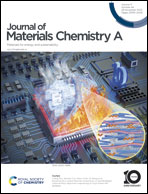Enhancing photocatalytic CO2 reduction to formate through one-pot self-assembly of a semiartificial cell†
Abstract
Enzymatic CO2 conversion by photocatalysis that mimics natural photosystems offers an eco-friendly method for transforming CO2 into valuable chemicals or fuels at a low cost. However, the primary challenge in artificial enzymatic conversion arises from the high energy loss caused by low electron transfer efficiency and the instability of enzymes due to the incompatibility between enzyme catalysts and photocatalysts. Integrating natural enzymes, photoharvesting component and electron mediators to build a semiartificial photosynthetic cell surpasses the natural photosynthetic system in terms of simplicity, directed charge transfer, altered enzyme conformation and light utilization efficiency. Herein, a semiartificial cell is constructed by co-assembly of photoantennas and enzymes on stacked nanorods within microspheres. The microspheres, formed through L-cystine self-assembly with excellent biocompatibility, facilitates the alteration of FDH to a conformation with an open active site cleft, exposing more active sites. The electron mediator (1-ethylamino-4,4′-bipyridine) is connected to meso-tetra(4-carboxyphenyl) porphyrin via an amide bond to enhance electron transport efficiency. By leveraging these attributes, formate production reaches 1.24 mmol gcat−1, and the semiartificial cell exhibits long-term durability.



 Please wait while we load your content...
Please wait while we load your content...